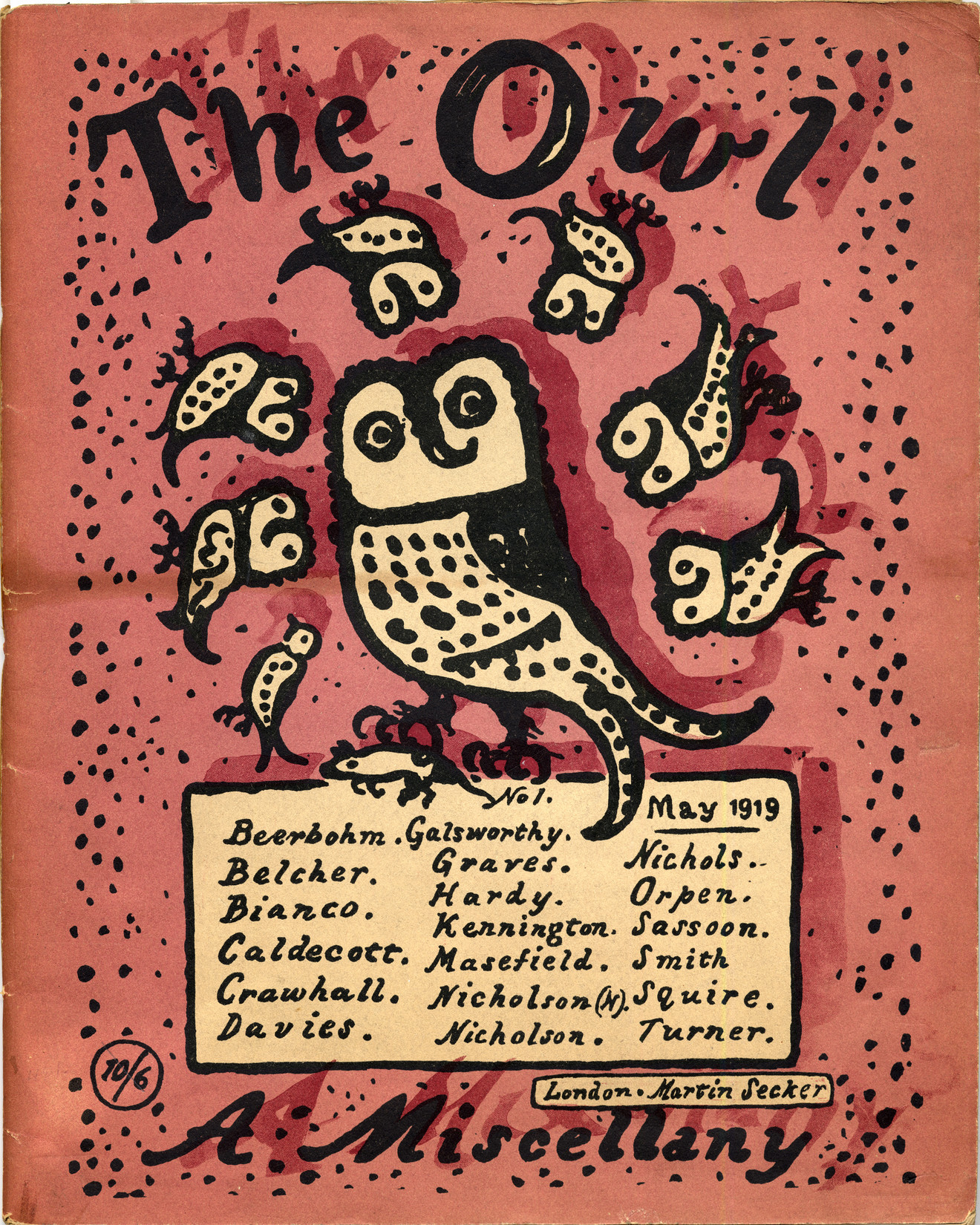
Title:
The Owl: A Miscellany (1919)
The Winter Owl (1923)
Publication Dates:.
May 1919 (1:1); Oct. 1919 (1:2); Nov. 1923 (2:3)
Place(s) of Publication:
London, England
Frequency of Publication:
Quarterly and irregular
Circulation:
Unknown
Publisher:
Cecil Palmer, 49 Chandos Street, Covent Garden, London
Physical Description:
Softbacked 13″ x 10″ red cover, woodcut of owl. Published poems, stories, essays, with full color illustrations. 50 – 90 pages.
Price:
12 shillings
Editor(s):
Robert Graves (May 1919 – Nov. 1923)
William Nicholson (Nov. 1923)
Associate Editor(s):
Unknown
Libraries with Original Issues:
Northwestern University; Duke University; Harvard University; Columbia University; University of Rochester; University of Michigan; University of Massachusetts, Amherst; Emory University
Reprint Editions:
Searchable PDFs of full run available online at Brown University’s Modernist Journals Project
The Owl was the brainchild of painter and children’s book illustrator Sir William Nicholson, who funded and contributed to the May 1919 inaugural issue. Unlike many of the little magazines of its time, The Owl rejected radical literary movements and published well-established writers instead. The magazine’s pages were filled with colorful illustrations and Georgian texts, embracing such themes as nature, childhood innocence, and traditional poetic wisdom (Vaughn 1). The Owl’s visual compositions – the artwork of many famous children’s book illustrators – also reflected these Georgian characteristics with storybook-like images.
The magazine operated under the editorial guidance of poet Robert Graves, son-in-law to Nicholson. Graves did not take any firm editorial stance in directing the magazine and its content; instead, he employed the mindset set forth in an essay by Lewis Carroll: “All owls are satisfactory” (“The Owl” 333). Unfortunately, this attitude did not carry the magazine very far. The hefty twelve shillings each issue cost did little to help sell copies of a magazine devoid of politics and filled with unfashionable contributors (Vaughn 2). The Owl was only issued three times before the creative endeavor failed.
The Owl declared its intentions on the first page of its initial issue:
“‘All owls are satisfactory,’ Lewis Carroll begins his essay on these birds: we accept the omen gratefully. It must be understood that “The Owl” has no politics, leads no new movement and is not even the organ of any particular generation–for that matter sixty-seven years separate the oldest and youngest contributors. But we find in common a love of honest work well done, and a distaste for short cuts and popular success. ”The Owl’ will come out quarterly or whenever enough suitable material is in the hands of the Editors.”
“Foreword.” The Owl, 1:1 (May 1919): 1.
Robert Graves (July 24, 1895 – Dec. 7, 1985)
Editor: May 1915; Oct. 1919
Touted as England’s “greatest living poet” by W. H. Auden in 1962, Robert Graves published over 140 books before he died (Graves). Born into an academic family in Wimbledon, England, he received encouragement to write from his father, a minor Irish poet, and mother, the daughter of a historical scholar. His studies were cut short in 1914 when he joined the Royal Welch Fusiliers, and four years of service left him wounded and traumatized. Nevertheless, writing remained his constant – even during the war Graves published three volumes of poetry (Graves). The rest of his life was spent teaching and writing. During his long career as poet, novelist, translator and literary scholar, Graves acquired a vast international reputation.
Sir William Newzam Prior Nicholson (Feb. 5, 1872 – May 16, 1949)
Editor: Nov. 1923
Best known for his work illustrating children’s stories, most notably The Velveteen Rabbit (1922) and Clever Bill, William Nicholson edited the final issue of The Owl. He studied at Herkomer’s Art School in Bushey, Hertfordshire, and Académie Julian in Paris before beginning a career in poster design with his brother. The artist won the Gold Medal in 1928 at the Olympic Games in Amsterdam in the Graphic Arts category, and was knighted in 1936.
Max Beerbohm
“Something Defeasible”
“Mr. William Nicholson”
“A Clergyman”
Pamela Bianco
Spring
Fairyland
W. H. Davies
“Love Impeached”
“Rogues”
John Galsworthy
“The Sun”
Robert Graves
“A Frosty Night”
“Ghost Raddled”
“Knowledge of God”
Thomas Hardy
“The Master and the Leaves”
“The Missed Train”
Vachel Lindsay
“The Golden Whales of California”
John Masefield
“Sonnet”
Walter de la Mare
“The Rabbit”
“Alas”
John Crowe Ransom
“Winter Remembered”
“An American Addresses Philomela”
“1928 Summer Olympics, Amsterdam, Netherlands, Art Contests.” Database Sports. 6 July 2009.
Images. “The Owl.” The Modernist Journals Project. Brown University. 17 July 2009.
The Modernist Journals Project. Brown University. 30 Oct. 2008.
“The Owl.” British Literary Magazines: The Modern Age, 1914-1984. Ed. Alvin Sullivan. Westport, CT: Greenwood Press, 1986. 333-336.
“The Owl.” British Poetry Magazines, 1914-2000: A History and Bibliography of ‘Little Magazines.’ Comp. David Miller and Richard Price. New Castle, DE: Oak Knoll, 2006. 38.
“Robert Graves.” Poets.org – Poetry, Poems, Bios & More. Academy of American Poets, 2008.
“Sir William Nicholson (1872 – 1949).” British Council: Art Collection. 6 July 2009.
Vaughn, Matthew R. Vaughn. “The Owl: An Introduction.” The Modernist Journals Project. Brown University. 27 Oct. 2008.
“The Owl” compiled by Callie Plaxco (Class of ’09, Davidson College)